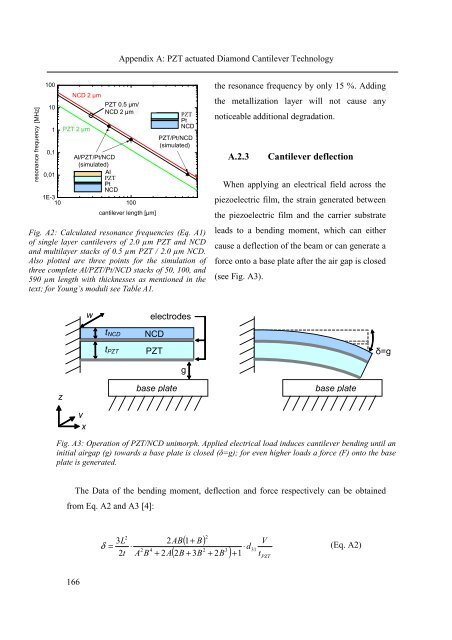PhD Thesis Arne Lüker final version V4 - Cranfield University
PhD Thesis Arne Lüker final version V4 - Cranfield University
PhD Thesis Arne Lüker final version V4 - Cranfield University
You also want an ePaper? Increase the reach of your titles
YUMPU automatically turns print PDFs into web optimized ePapers that Google loves.
esonance frequency [GHz] [MHz]<br />
100<br />
10<br />
1<br />
NCD 2 µm<br />
PZT 2 µm<br />
166<br />
Appendix A: PZT actuated Diamond Cantilever Technology<br />
PZT 0.5 µm/<br />
NCD 2 µm<br />
0,1<br />
Al/PZT/Pt/NCD<br />
(simulated)<br />
0,01<br />
Al<br />
PZT<br />
Pt<br />
NCD<br />
1E-3<br />
10 100<br />
cantilever length [µm]<br />
the resonance frequency by only 15 %. Adding<br />
the metallization layer will not cause any<br />
noticeable additional degradation.<br />
A.2.3 Cantilever deflection<br />
When applying an electrical field across the<br />
piezoelectric film, the strain generated between<br />
the piezoelectric film and the carrier substrate<br />
leads to a bending moment, which can either<br />
cause a deflection of the beam or can generate a<br />
force onto a base plate after the air gap is closed<br />
(see Fig. A3).<br />
The Data of the bending moment, deflection and force respectively can be obtained<br />
from Eq. A2 and A3 [4]:<br />
PZT<br />
Pt<br />
NCD<br />
PZT/Pt/NCD<br />
(simulated)<br />
Fig. A2: Calculated resonance frequencies (Eq. A1)<br />
of single layer cantilevers of 2.0 µm PZT and NCD<br />
and multilayer stacks of 0.5 µm PZT / 2.0 µm NCD.<br />
Also plotted are three points for the simulation of<br />
three complete Al/PZT/Pt/NCD stacks of 50, 100, and<br />
590 µm length with thicknesses as mentioned in the<br />
text; for Young’s moduli see Table A1.<br />
z<br />
y<br />
x<br />
w<br />
tNCD<br />
tPZT<br />
electrodes<br />
NCD<br />
PZT<br />
base plate<br />
g<br />
( 1+<br />
B)<br />
2<br />
2<br />
3L<br />
2AB<br />
V<br />
δ = ⋅<br />
⋅ d<br />
(Eq. A2)<br />
2 4<br />
2t<br />
A B + 2A<br />
2 3 31<br />
( 2B<br />
+ 3B<br />
+ 2B<br />
) + 1 tPZT<br />
base plate<br />
Fig. A3: Operation of PZT/NCD unimorph. Applied electrical load induces cantilever bending until an<br />
initial airgap (g) towards a base plate is closed (δ=g); for even higher loads a force (F) onto the base<br />
plate is generated.<br />
δ=g

















